Overview
The article outlines the key benefits of transitioning from a career to business ownership, emphasizing the importance of self-assessment and leveraging corporate skills for entrepreneurial success. It supports this by detailing how understanding personal motivations, financial readiness, and transferable skills can enhance job satisfaction, work-life balance, and potential financial growth, ultimately paving the way for a fulfilling entrepreneurial journey.
Introduction
Embarking on the journey to business ownership is an exciting yet complex endeavor that requires careful consideration and preparation. Aspiring entrepreneurs must first assess their readiness, reflecting on their motivations and evaluating their financial stability, support systems, and risk tolerance. This foundational introspection sets the stage for a successful transition, enabling individuals to leverage their corporate skills and adapt them to the demands of entrepreneurship.
As they navigate this path, the benefits of business ownership become clear—greater flexibility, job satisfaction, and the potential for significant financial rewards await those who take the leap. However, success does not come without challenges; a strategic transition plan is essential for overcoming obstacles and achieving long-term goals.
By understanding the intricacies of this transition and employing practical strategies, individuals can confidently pursue their entrepreneurial dreams and create a lasting impact in their chosen fields.
Assessing Your Readiness for the Transition to Business Ownership
Before starting the journey to ownership, a thorough assessment of your readiness is paramount. Start by contemplating your motivations: What fuels your desire to own a venture? Understanding your ‘why’ is crucial.
The guidebook ‘Your Profession 2.0: A Survival Guide for The Battered Professional Syndrome and Investor Syndrome’ serves as an essential resource in this introspective process, helping you explore these motivations deeply. This detailed manual is tailored specifically for aspiring entrepreneurs, addressing the unique challenges posed by the Battered Profession Syndrome and Investor Syndrome. Next, evaluate your financial situation—are your resources sufficient to sustain both your personal and business needs during the initial stages?
Additionally, consider your support systems, such as family and mentors, as well as your risk tolerance, which plays a significant role in navigating the uncertainties of entrepreneurship. Engaging with self-assessment tools, as recommended in ‘Your Career 2.0’, can provide valuable insights into your strengths and areas for growth. As Douglas Garner, Partner at Smart Work, aptly states,
It includes a complete self-assessment of the key characteristics that most influence entrepreneurial success and then recommends your unique self-employed career strategy.
This introspective process not only lays the groundwork for a successful transition but also highlights the benefits of how to transition from career to business ownership, ensuring you are mentally and emotionally prepared for the challenges that lie ahead. Leveraging statistics can further enhance the accuracy of your evaluations, making informed decisions based on evidence and reliable data. For example, a control group of 17,000 participants evaluated on their proficiency in 23 practical, job-related abilities demonstrates the effectiveness of structured self-assessments.
Additionally, the case study titled ‘Using Statistics for Self-Evaluation’ highlights how data can improve the reliability of self-evaluations, enabling organizations to make informed decisions. Regular self-assessments, as seen in many public sector organizations, emphasize the importance of this practice for aspiring entrepreneurs. This comprehensive approach will establish a solid foundation as you learn about the benefits of how to transition from career to business ownership.
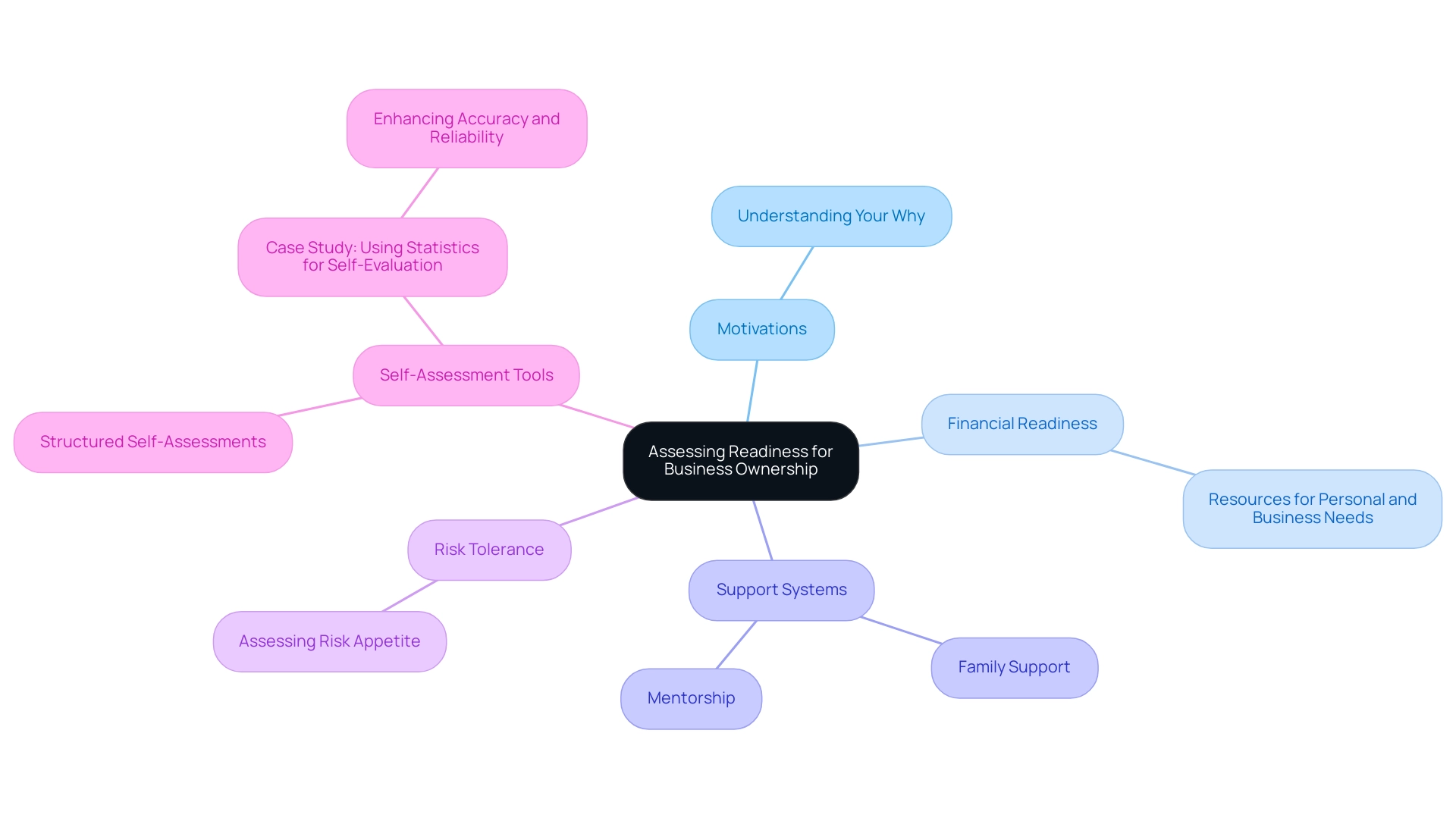
Leveraging Corporate Skills for Entrepreneurial Success
In today’s rapidly changing job market, the abilities developed in the corporate arena are vital tools for aspiring entrepreneurs, illustrating the benefits of how to transition from career to business ownership. Project management, team leadership, and effective communication emerge as essential competencies. As Kayla Voigt aptly notes, ‘Traits like patience, empathy, flexibility, creativity, or perseverance are all transferable skills that serve you well regardless of your company’s growth stage.’
The urgency to transition to entrepreneurship has never been clearer, highlighting the benefits of how to transition from career to business ownership, especially with over 36.4 million workers filing for unemployment due to COVID-19. Income growth, a significant short-term goal for many, can reduce stress associated with bills and home maintenance, as highlighted in the case study ‘There is No Time Like the Present.’ This growth not only enhances economic stability but also fosters a sense of security that empowers individuals to pursue their entrepreneurial dreams.
It’s noteworthy that 64% of small enterprises start with as little as $10,000 in capital, and 58% launch with no more than $25,000, providing a realistic financial context for aspiring entrepreneurs. Considering the notable shift towards self-employment—an estimated 27 million Americans are anticipated to move from full-time positions to entrepreneurship by the end of 2020—the benefits of how to transition from career to business ownership make now the ideal moment to utilize your current abilities. Take a moment to identify your competencies and consider how they can be adapted to the unique demands of running a business.
Creating a detailed list of these abilities not only boosts your confidence but also sets a clear framework for your entrepreneurial journey. Emphasizing these transferable skills can significantly contribute to your success in navigating this new path.
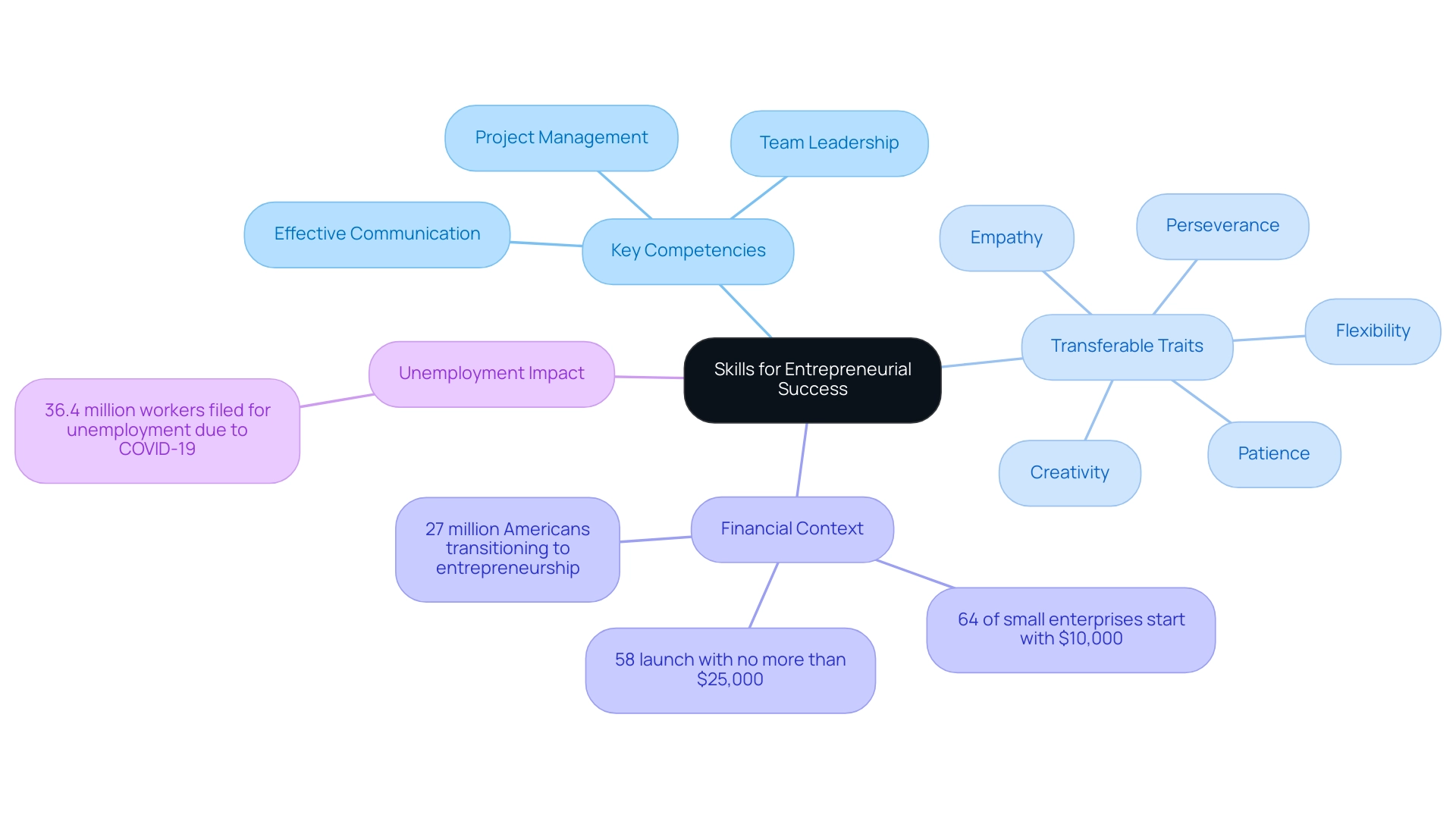
Exploring the Benefits of Business Ownership
Transitioning to entrepreneurship provides various advantages, highlighting the benefits of how to transition from career to business ownership that can significantly enhance your professional and personal life. One of the most compelling benefits of how to transition from career to business ownership is the flexibility to establish your own schedule, which fosters an improved work-life balance that many traditional jobs struggle to offer. In fact, studies reveal that the benefits of how to transition from career to business ownership often lead entrepreneurs to report higher job satisfaction, which contributes to a healthier lifestyle.
Financially, the substantial benefits of how to transition from career to business ownership can be significant; as enterprises grow, entrepreneurs have the potential to earn six figures annually, far surpassing the income of many salaried positions. This financial growth, combined with the profound sense of accomplishment derived from understanding the benefits of how to transition from career to business ownership, can be incredibly fulfilling. As Narayan Murthy aptly states, Your contribution to the tech industry has inspired millions, creating an ecosystem that has… This encapsulates not only personal success but also the broader impact of entrepreneurship.
Moreover, owning an enterprise provides the unique opportunity to build a legacy, highlighting the benefits of how to transition from career to business ownership, whether through a family venture or a community contribution. Many entrepreneurs discover the benefits of how to transition from career to business ownership, as their ventures enable them to support local initiatives or create lasting family traditions, offering a sense of achievement that traditional employment may not provide. Furthermore, as you navigate your journey towards entrepreneurship, it’s essential to embrace education and coaching to fully grasp the benefits of how to transition from career to business ownership.
Taking classes centered on strategic planning, marketing, and financial management provides aspiring entrepreneurs with crucial abilities and networking opportunities that are priceless in today’s competitive environment. With the right guidance, you can clarify your entrepreneurial goals, overcome challenges, and recognize the benefits of how to transition from career to business ownership to ultimately take control of your destiny. It’s also crucial to consider the current job market, where employability can be a concern, especially for those facing age factor limitations.
However, your strong transferable skills, which may include leadership, problem-solving, and adaptability, are significant assets in this transition. Embrace these opportunities as you contemplate your future in entrepreneurship, and remember that your supportive community can significantly contribute to your success.
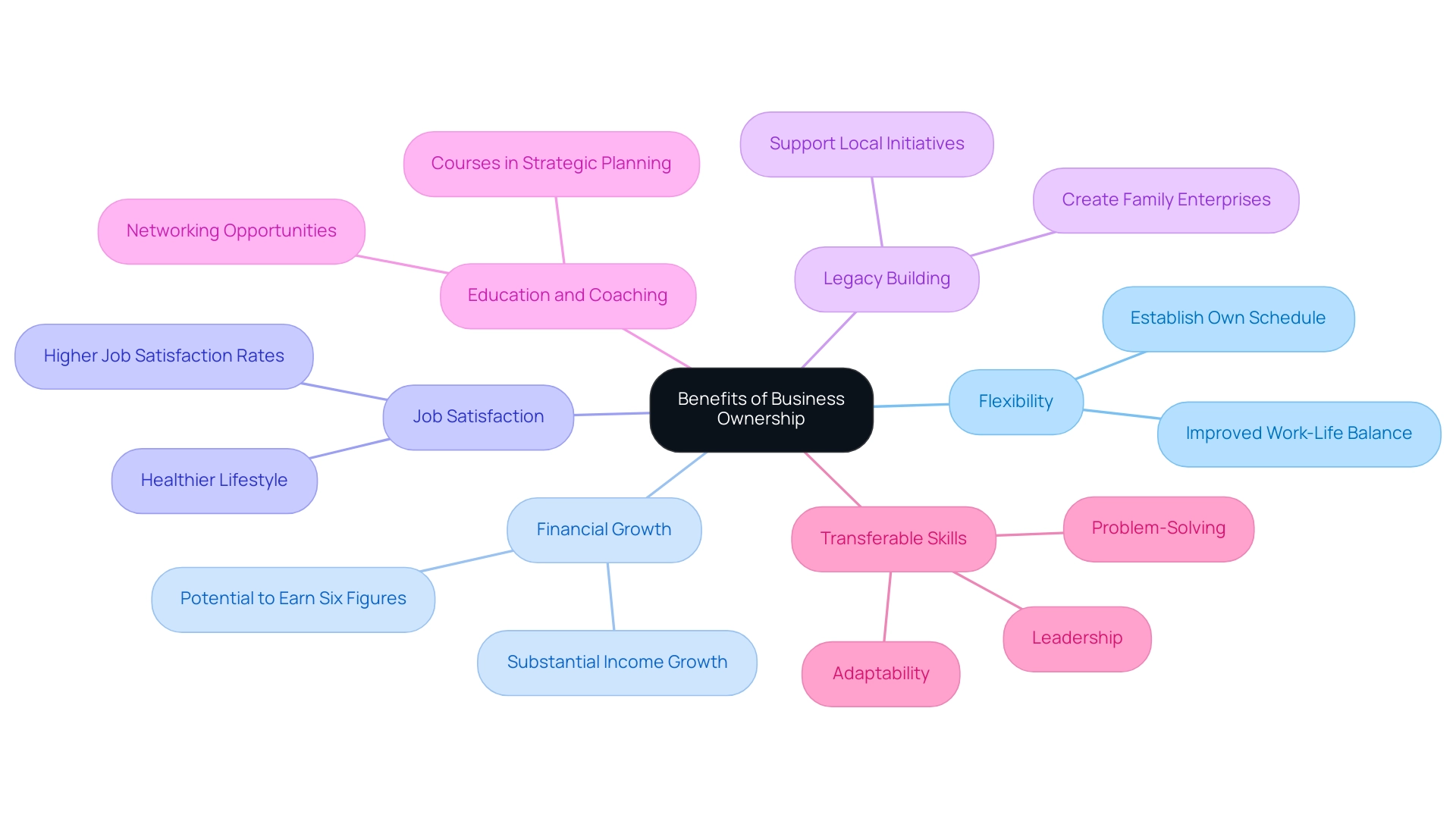
Crafting a Strategic Transition Plan for Success
Crafting a strategic transition plan is vital for aspiring entrepreneurs to recognize the benefits of how to transition from career to business ownership and involves several essential steps. Begin by clearly defining your goals and objectives—consider what you wish to achieve both in the short term and over the longer horizon. A well-articulated vision sets the foundation for your entrepreneurial journey.
It is crucial to understand your organization’s current position and desired destination to effectively define your strategy. Next, conduct thorough market research to gain insights into your target audience and assess your competitors. This is not merely a formality; 71% of rapidly expanding companies—those with over 92% year-over-year sales growth—attribute their success to having a solid plan in place, highlighting the importance of this step.
Furthermore, 25% say one of the main reasons strategic initiatives succeed is good communication, highlighting the need for clear communication throughout the planning process. Following this, develop a commercial model that outlines your offerings and revenue streams, ensuring alignment with the insights gained from your research. Financial planning is another critical component, encompassing budgeting and exploring funding options, including self-funding through checking and savings accounts.
Aspiring entrepreneurs can utilize these accounts to set aside funds specifically for initiatives or emergencies, allowing for greater financial flexibility. Additionally, consider the various funding options available from the U.S. Small Business Administration, which offers programs such as microloans, guaranteed loans, and counseling services that can provide valuable resources for new entrepreneurs. By integrating strategic planning tools such as:
- SWOT Analysis
- PESTEL Analysis
- Balanced Scorecard
you can systematically identify strengths, weaknesses, opportunities, and threats, thereby enhancing your planning and execution.
For those grappling with career transitions, resources like ‘Your Career 2.0: A Survival Guide for The Battered Career Syndrome and Investor Syndrome’ can offer essential insights for navigating these challenges, including strategies for building resilience and leveraging transferable skills. By crafting a detailed transition plan, you create a clear roadmap that showcases the benefits of how to transition from career to business ownership, guiding you through the complexities of starting a new venture and significantly increasing your chances of success in the competitive entrepreneurial landscape.
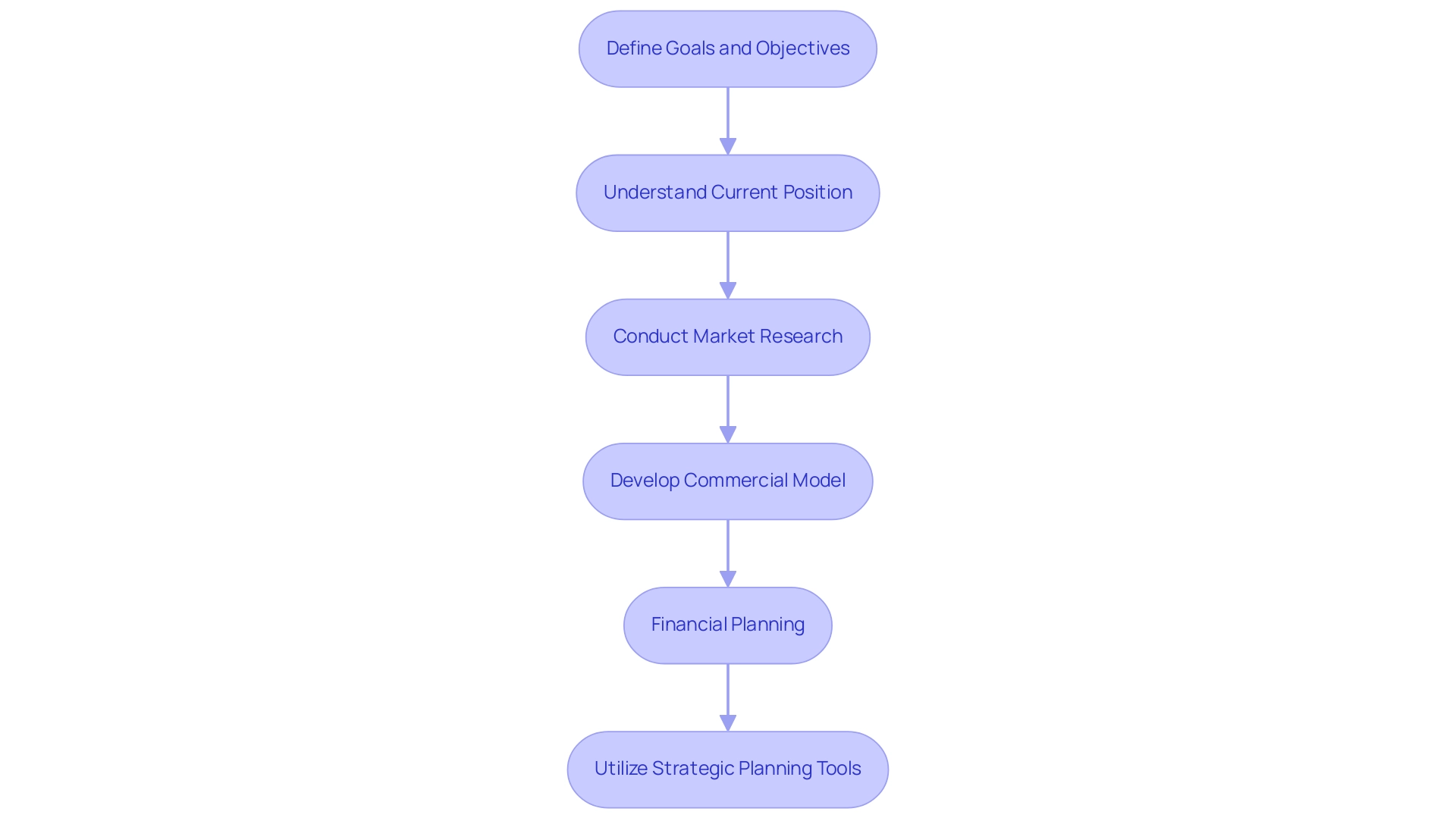
Navigating Challenges in the Transition to Business Ownership
The challenges of transitioning to ownership, such as financial uncertainty, the need for self-discipline, and the risk of isolation, highlight the benefits of how to transition from career to business ownership. In Your Career 2.0: A Survival Guide for The Battered Career Syndrome and Investor Syndrome, you’ll find essential insights to help navigate these hurdles effectively. The Small Enterprise Administration’s Office of Advocacy reveals that nearly all (99.9%) of American establishments are small, underscoring their crucial role in the economy.
However, a mere 13% of small enterprises currently leverage AI to identify lower-cost suppliers, pointing to a significant opportunity for growth in adapting to economic pressures. Establishing a robust support network is vital, as connecting with mentors, joining networking groups, or engaging in professional associations can help you understand the benefits of how to transition from career to business ownership. Additionally, maintaining clear boundaries and a disciplined work ethic is essential for managing the demands of entrepreneurship.
With 41% of individuals using voice search daily, adapting to technological trends is crucial for success in the marketplace. Remember, setbacks are a natural part of the entrepreneurial journey—recognizing the benefits of how to transition from career to business ownership will show that resilience and adaptability will serve as your greatest assets in carving a successful path in ownership. The professional, scientific, and technical services sector, which includes 4.53 million small enterprises, underscores the varied environment and obstacles encountered by new entrepreneurs.
With the computer systems and design sector projected to grow significantly, adding over 574,000 jobs, now is an opportune time to embrace these challenges and build your venture towards financial independence. To dive deeper into these insights and strategies, be sure to ‘Get the book and empower your journey towards business ownership.
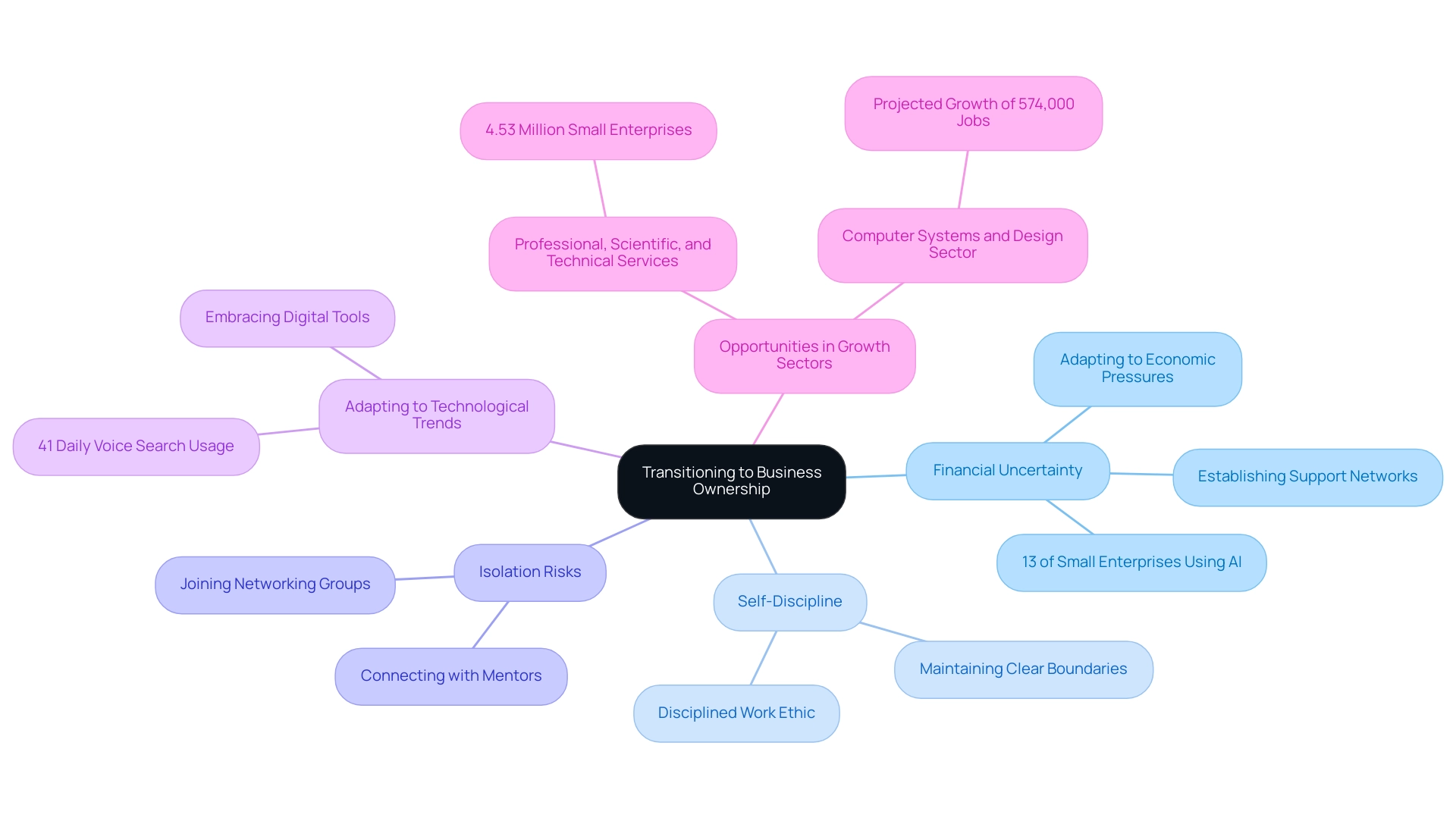
Conclusion
Transitioning to business ownership involves a thoughtful assessment of personal readiness. Aspiring entrepreneurs should reflect on their motivations, evaluate financial stability, and understand the support systems available to them. Resources like “Your Career 2.0” can provide valuable insights and self-assessment tools to ensure preparedness for the challenges ahead.
Utilizing corporate skills—such as project management and effective communication—can greatly enhance success in entrepreneurship. As many seek to pivot to self-employment, adapting these competencies is essential for navigating the entrepreneurial landscape.
The benefits of entrepreneurship are significant, offering flexibility, job satisfaction, and the potential for substantial financial rewards. Moreover, the chance to create a legacy and positively impact communities adds a fulfilling dimension that traditional jobs may lack. Engaging in continuous learning and coaching helps clarify goals and tackle challenges effectively.
A strategic transition plan is crucial for long-term success. Defining clear objectives, conducting market research, and developing a robust business model are foundational steps that increase the likelihood of success. Recognizing challenges, such as financial uncertainty and the need for self-discipline, empowers individuals to build resilience and create supportive networks.
In summary, the journey to business ownership is both rewarding and complex. By assessing readiness, leveraging skills, embracing the benefits of entrepreneurship, and crafting a strategic plan, aspiring entrepreneurs can approach this transition with confidence. With determination and the right resources, the dream of business ownership can become a reality, fulfilling personal aspirations while making a meaningful impact.
Frequently Asked Questions
Why is it important to assess readiness before starting a business?
Assessing readiness is crucial to understand your motivations, financial situation, support systems, and risk tolerance, which lays the groundwork for a successful transition to business ownership.
What resources can help in the self-assessment process?
The guidebook “Your Profession 2.0: A Survival Guide for The Battered Professional Syndrome and Investor Syndrome” is a key resource that helps aspiring entrepreneurs explore their motivations and challenges.
How should I evaluate my financial situation before starting a business?
You should assess whether your resources are sufficient to support both your personal and business needs during the initial stages of entrepreneurship.
What role do support systems play in entrepreneurship?
Support systems, including family and mentors, are essential for navigating the uncertainties of entrepreneurship and can provide guidance and encouragement throughout the journey.
How can self-assessment tools benefit aspiring entrepreneurs?
Self-assessment tools can provide insights into your strengths and areas for growth, helping you develop a unique self-employed career strategy that aligns with your entrepreneurial goals.
What is the significance of using statistics in self-evaluations?
Statistics can enhance the reliability of self-evaluations, enabling informed decision-making based on evidence and structured assessments, as demonstrated by case studies involving large participant groups.
What skills are important for transitioning from a corporate job to entrepreneurship?
Essential skills include project management, team leadership, effective communication, and transferable traits like patience, empathy, flexibility, creativity, and perseverance.
How has the job market influenced the urgency to transition to entrepreneurship?
The COVID-19 pandemic has led to significant unemployment, prompting many individuals to consider entrepreneurship as a viable option for income growth and economic stability.
What is the typical startup capital for small enterprises?
Approximately 64% of small enterprises start with as little as $10,000 in capital, and 58% launch with no more than $25,000, providing a realistic financial context for aspiring entrepreneurs.
How can identifying transferable skills aid in the entrepreneurial journey?
Creating a detailed list of your competencies boosts confidence and provides a clear framework for navigating the challenges of running a business, emphasizing skills that are applicable across different contexts.


